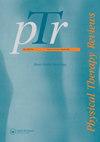Rehabilitation strategies and neurological consequences in patients with COVID-19: part I
IF 0.8
Q4 REHABILITATION
引用次数: 1
Abstract
Abstract Background The 2019 novel coronavirus disease (COVID-19) pandemic has triggered a devastating effect worldwide. In addition to cardiovascular, pulmonary, and musculoskeletal deconditioning, reports of neurological consequences (e.g. stroke, critical illness polyneuropathy, myopathy, vertigo, headaches, facial palsy, and delirium) are growing increasingly common. Objectives Part I of this review of rehabilitation strategies and neurological consequences in patients with COVID-19 sought to consider potential rehabilitation strategies for managing the emerging neurological consequences of COVID-19. Methods An exploratory review was conducted that comprised a narrative synthesis in two parts. Part I focused on neurological consequences and physiotherapy and rehabilitation approaches. Part II focused on the general principles of rehabilitation interventions and precautions that should be considered. Literature on the use of the neurorehabilitation approaches was also included in the review. Results Rehabilitation services include inpatient and outpatient rehabilitation services. With respect to the recovery of mobility and function, an interdisciplinary approach was generally involved. Conclusions A thorough assessment and the development of an individualized, progressive treatment and rehabilitation plan should be implemented by focusing on existing function, any disabilities, the desire to return to participation in society, and maximizing function and quality of life. It should be noted that neurorehabilitation should not be delayed and be completed for all patients with COVID-19 of all levels in need.新冠肺炎患者的康复策略和神经系统后果:第一部分
背景2019年新型冠状病毒病(COVID-19)大流行在全球范围内引发了毁灭性影响。除了心血管、肺部和肌肉骨骼疾病外,神经系统后果(如中风、危重疾病多神经病变、肌病、眩晕、头痛、面瘫和谵妄)的报告也越来越普遍。本综述的第一部分回顾了COVID-19患者的康复策略和神经系统后果,旨在考虑治疗COVID-19新出现的神经系统后果的潜在康复策略。方法进行探索性综述,包括两部分的叙事综合。第一部分着重于神经后果和物理治疗和康复方法。第二部分侧重于康复干预的一般原则和应考虑的预防措施。关于使用神经康复方法的文献也包括在回顾中。结果康复服务分为住院康复和门诊康复。关于活动能力和功能的恢复,通常涉及跨学科的方法。结论应通过关注现有功能、任何残疾、重返社会参与的愿望以及最大限度地提高功能和生活质量来实施全面的评估和制定个性化的渐进式治疗和康复计划。需要注意的是,神经康复不应拖延,应针对所有有需要的各级新冠肺炎患者完成康复。
本文章由计算机程序翻译,如有差异,请以英文原文为准。
求助全文
约1分钟内获得全文
求助全文
来源期刊

Physical Therapy Reviews
REHABILITATION-
CiteScore
1.30
自引率
0.00%
发文量
26
期刊介绍:
Physical Therapy Reviews is an international journal which aims to publish contemporary reviews, discussion papers and editorials within physical therapy, and in those basic and clinical sciences which are the basis of physical therapy. The journal is aimed at all those involved in research, teaching and practice within the area of physical therapy. Reviews (both descriptive and systematic) are invited in the following areas, which reflect the breadth and diversity of practice within physical therapy: •neurological rehabilitation •movement and exercise •orthopaedics and rheumatology •manual therapy and massage •sports medicine •measurement •chest physiotherapy •electrotherapeutics •obstetrics and gynaecology •complementary therapies •professional issues •musculoskeletal rehabilitation
 求助内容:
求助内容: 应助结果提醒方式:
应助结果提醒方式:


